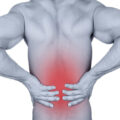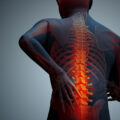Low back pain
Low back pain is one of the most common complaints during primary care office visits. It is estimated that approximately 80% of all Americans report low back problems at some time in their lives. Among working age people, as many as 20 percent experience back symptoms at least every year. In the United States, spinal diseases are the most common cause of disability in persons under the age of 45. What is even more surprising is that the estimated costs of direct medical and indirect expenses for low back pain in the U.S. range from $20 to $100 billion annually. Spine care results in expenditures two to three time greater than cardiac services for many health plans.
Some of the main causes of back pain include spinal stenosis, sciatica, muscle strain, bulging or herniated discs and degenerative disc disease. Herniated intervertebral discs (HID) are the most common cause of low back pain associated with a defined structural abnormality.
Low back pain therapy by Ozone
One of the treatment that has been receiving exposure in Europe is the use of medical ozone (02/03 mixture) in the treatment of HID. Medical ozone has been widely used in Europe for 40 years and now is seriously being looked at as a possible treatment for herniated discs and other types of lower back pain. In order to acquire an understanding about the biochemical action of ozone in treating HID, a foundation of the structure of the intervertebral disc and diagnostic criteria of HID is essential
The use of medical ozone in the treatment of HID was developed by Cesare Verga (an orthopedic surgeon) in 1983. Dr. Verga has since treated over 8,000 patients with HID and documented a 95% cure rate (35% of these cases had at least one prior surgical intervention). In 80% of the clinically healed cases there are also corresponding CT and MRI images confirming resolution. In 15 years of treatments Dr. Verga states that relapses occur in less than 2% of cases. The method he uses which we will term the “Verga Method” (VM), involves the administration of 40/60 cc of ozone gas (O2-O3 mixture) at a concentration of 20/30 micrograms per cc, repeated 8-14 times. The injection is generally made into the paravertebral musculature, and in the hernia zone. The injection itself, except for a slight sense of localized pain of short duration, is generally painless and well tolerated. There have been a number of European studies confirming the efficacy of the “Verga Method” and new studies are currently underway.
How does Ozone Therapy using the “Verga Method” work? Although the exact mechanism of action is not completely understood, there are a number of characteristics of medical ozone that offer some insights into its mode of action in treating HID. Thus, it has been hypothesized that the success of the “Verga Method” is based on four main biochemical actions on the intervertebral disc and its surrounding tissues. The various proposed mechanisms of action are:
Mechanisms of action
1.Several studies suggest disc inflammation as a mechanism of sciatica due to disc herniation. Ozone has been shown to have an effect on the inflammatory cascade by altering the breakdown of arachidonic acid to inflammatory prostaglandins. Therefore, by reducing the inflammatory components there is a corresponding reduction in pain.
2.Another hypothesis as to the mechanism of action of the VM is based on the fact that the circulatory environment around a HID can be compromised. The herniation can impinge on the venous and arterial flow and cause phlebostasis and arteriostenosis. The combination of these two conditions can then lead to a serious hypoxemia. These factors can contribute to the pain experienced with a HID. In fact, the sensory roots more so than the motor are particularly sensitive to anoxia. By applying the ozone to HID area, both a direct and indirect hyperoxygenation of the zone occurs, which reduces the pain. The direct effect is the oxygen directly diffusing into the area. The indirect action is the ozone causing an increase in 2,3-DPG (diphosphoglycerate) which has a direct effect in the release of O2 from hemoglobin.[12] The end result is an increase in the amount of oxygen and a reduction in anoxia.
3.The third plausible mechanism of action is the direct effect of the ozone on the herniation. It is well established that the nucleus pulposus (the actual part of the disc that herniates) is 70-90% water contained within the domain of proteoglycans.[13] The water binding capacity of the proteoglycan molecule is partially a property of its size and physical shape, but the main force that holds water to the molecule stems from the ionic, carboxyl (COOH) and sulphate (SO4) radicals of the glycosaminoglycan chains. The ozone can have a direct effect on these carboxyl and sulphate groups, breaking down some of these glycosaminoglycan chains which make up the proteoglycans. The destruction of these cross-linked structures reduces their ability to hold water therefore diminishing the size of the herniation.
4.Another action which may prove to be one of the most important is the stimulation of fibroblastic activity by ozone. Fibroblasts initiate the repair process by stimulating the deposition of collagen. Although yet to be validated, this mode of action could explain the resolution of HID on CT scans and the small percentage of patients who have relapses after the completion of treatment plan.
References
http://www.o3center.org/Articles/OzoneTherapyfortheTreatmentofHerniatedIntervertebralDiscs.html






